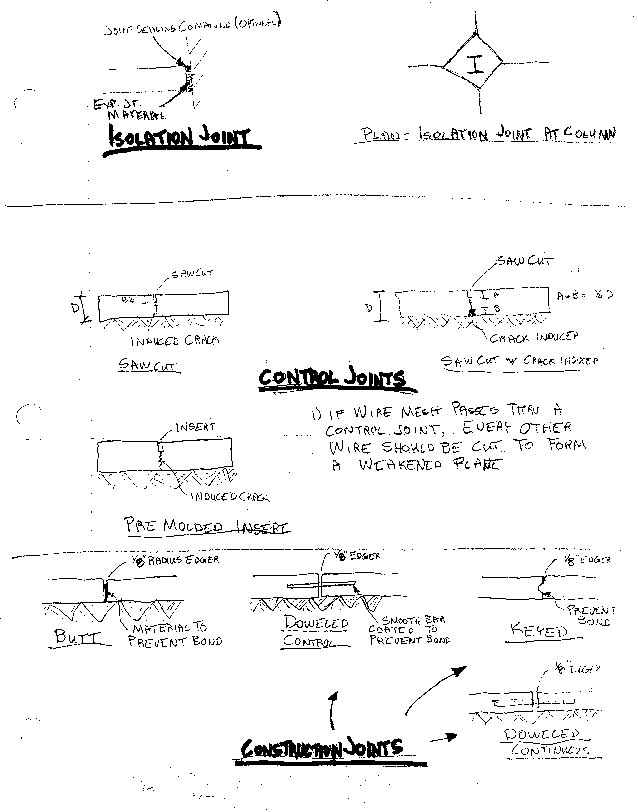 CONSTRUCTION KNOWLEDGE >>
CONCRETE >>
CONSTRUCTION KNOWLEDGE >>
CONCRETE >>
SLABS ON GRADE
1. What are the Basics of Slabs on Grade?
2. How do the Joints Work for Slabs on Grade?
3. What Should I Know About Installing Slabs on Grade?
4. What Public Domain Documents are Available for Further Study?
5. Tricks of the Trade & Rules of Thumb for Slabs on Grade:
What are the Basics of Slabs on Grade?
People outside the construction business wonder what can be
complicated about a “cement” floor. If they only knew. The concrete
floor is often the most used, and noticed, part of the building. With
that amount of importance, one would think that we would usually get
them right. Unfortunately, it is all too rare that the concrete floor
meets the criteria of Owner, design professional and contactor through
out the life of the building.
You may wonder, “Why is it so difficult to obtain and economical,
serviceable concrete floor.” The best way to approach this question is
to examine some of the things that go wrong. Generally problems stem
from construction practices, materials, or improper design. A list of
concrete floor problems follows:
- Cracking – structural
- Cracking – shrinkage
- Curling- Top of slab shrinks more than bottom and slab edge lifts.
- Scaling – Hardened concrete breaking away from slab top in sheets 1/8” to ¼” thick.
- Dusting – Appearance of powdery material at slab surface.
- Crazing – Many fine hairline cracks in a new slab which resemble a road map.
- Spalling – disintegration of concrete at joint edges.
In order to avoid the above problems, all the details of a concrete
slab, from design to curing, must be performed appropriately. Due to the
importance of the floor, we will examine a step-by-step procedure for
obtaining an acceptable concrete slab-on-grade.
The first step in the process is the concrete design mix. Rarely does
low quality concrete produce a high quality floor. A 4000 psi concrete
is recommended instead of a 3000 psi mix due to the higher cement
content and improved wear resistance. The Portland Cement Association
recommends that a commercial or industrial concrete floor use a concrete
with a three day compressive strength of 1800 psi. This requirement
provides early protection from construction traffic. Water-cement ratio
is also critical for concrete slabs-on-grade in order to minimized
shrinkage cracking.
![]()
How do the Joints Work for Slabs on Grade?
The proper design and location of joints is an area of confusion throughout the construction industry. There are three types of joints:
- Isolation Joint – Used to prevent a bond and allow movement between the slab and the adjoining structure.
- Control Joint – Used to induce shrinkage cracking at specific locations.
- Construction Joint – Used to provide a stopping place for a concrete pour. The construction joint can also be detailed to function as an isolation or control joint.
The basic theory of joints must be understood in order to use the
correct joint at the correct location. The isolation joint should be
used to allow the concrete floor and the rest of the structure to act
independently. There is not key way or bond of any type through an
isolation joint, allowing movement both horizontally and vertically.
The figure below illustrates a typical isolation joint detail and a plan of
an isolation joint at a steel column. The isolation joint at a column is
often in the diamond shape so the slab control joints stop on an
isolation joint corner (this reduces cracking). The isolation joint
diamonds must also be formed separately and poured after the floor slab.
The joint sealing compound shown is another topic worthy of discussion.
The installation of joint sealers is costly because the expansion joint
material must be kept about ½” low and a removable strip installed. The
sealant installer can remove this strip and begin sealing. I have seen
many cases where joint sealant was shown on drawings, with perhaps a
less than full awareness of cost by the design professional, and then
never installed in the field.
This is a bad situation for everyone, since the owner paid for something
he didn’t get and the contractor left himself open for claims. When
joint sealant is shown on the drawings, I think it advisable to discuss
costs, requirements and details with the owner and design professional
to agree on what should be performed in the field.
The control joint functions as a contraction joint, allowing the
shrinkage of the concrete slab to occur in one location rather than
random cracking in the slab. A control joint is a weakened plane in the
slab that is supposed to rack. If a crack appears two feet (and
parallel) from a control joint, one can be reasonably sure the control
joint did not create a weakened plane. Isolation joints always function
as control joints and construction joints usually do.
Three types of pure control joints are shown in figure below. The saw cut
joints are sawed by a concrete saw as soon as the saw does not crack the
saw cut edges. If one waits a few hours too long to saw cut, the slab
shrinkage may have created its own cracks. A saw cut is typically
considered adequate to a depth of ¼ the slab thickness. The induced
crack that form below the saw cut is usually jagged enough to continue
lock the slabs together and prevent differential settlement. It is also
possible, though not common, to use smooth dowels through a control
joint that are coated to prevent bond.
For thicker slabs, a crack inducer can be placed on the sub-grade to
reduce the thickness of the saw cut required. Finally an insert can be
placed in the plastic concrete to create a control joint. The insert can
be a simple hardboard strip or one of several products on the market for
this use. Care must be taken to keep these pre-molded insert strips
straight while installing.

A construction joint is first and foremost a place to start and stop
pouring concrete. The details of a construction joint can allow it to
act as a isolation joint, control joint, or continuous joint. The butt joint acts as an isolation
joint allowing both vertical and horizontal movement. The dowel control
and keyed joints both act as control joints, allowing horizontal
movement but preventing vertical movement. Finally the doweled
continuous joint should allow no movement.
While the construction supervisor should never just change the concrete slab
joint details to something that seems to make more sense, he should
consider the joints required and make appropriate recommendations to the
owner or design/professional. Concrete floors are too much work to do a
second time.
What Should I Know About Installing Slabs on Grade?
The many specific details of forming, placing, finishing, and curing a
concrete slab are not included here. The information presented here
highlights trouble areas that a construction supervisor can concentrate on to try
to achieve an acceptable concrete floor. In order to review all the
specifics of concrete floor construction, however, I would recommend a
publication from the American Concrete Institute entitled “Concrete
Craftsman Series – Slabs-On-Grade”.
An area of the floor system that is crucially important is the sub-grade
on sub-base. The most important item is proper compaction; many floors
settle and have structural cracks. Of course organic material can not be
properly compacted and must never be in the sub-grade. It is a simple
fact that the floor system rests on the grade and if the sub-grade
settles the floor settles.
Particular attention should be paid to backfilling trench and footing
excavations under a floor. While it is worthwhile to make the contractor
perfuming the work responsible for the quality of backfill, the
construction supervisor should realize that his step, by itself, may not solve
the problem. The contractor backfilling under a future slab must clearly
understand the required quality level of the backfill and assure its
acceptability.
Forming of concrete floors is reasonably straight forward. One must
remember, though, that loose or warped edge forms cause uneven floors.
Therefore, the care taken with the edge form setting will be
proportional to final flatness of the floor.
Placing concrete in hot weather, particularly when the walls and roof
are not yet completed, creates some additional quality concerns. Plastic
cracking is one of the worse problems that occur. Plastic shrinkage
cracks form before the concrete hardens and are caused by hot, dry,
and/or windy conditions. The cracks resemble the shrinkage cracks seen
in clay soils during very dry weather.
Curing can also create lots of problems for concrete floors. Since water
evaporates so quickly from the large exposed surface, without proper
curing methods a floor is likely to rack, craze and dust. The three most
common means of curing are:
- Wet cure by covering, after finishing, with continuously watered burlap.
- Wet cure by watering finished slab and covering with plastic or paper.
- Seal cure with liquid membrane curling compound.
The construction supervisor should verify that the method chosen is acceptable to the Owner and Design Professional.
What Public Domain Documents are Available for Further Study?
The US Dept of Defense produced a 59 page training document that has some good joint details and design guides for understanding Concrete Floors. Titled Concrete Floor Slabs on Grade Subjected to Heavy Loads, the official name is UFC 3-320-06A, 1 March 2005.
This US Department of Army Concrete and Masonry Field Manual does a great job explaining Concrete and Masonry basics. It's 323 pages of figures, basic explanations and instructions of how to do the work. If you are somewhat new to construction, take some time and review this excellent resource. The official name is US Army FM 5-428.
Another great all around great construction introductory guide that
covers some concrete installation items is the US Navy
Builder Training Course Volume #1. The official name of this 332
page resource is Builder 3 and 2, Volume #1, NAVEDTRA 14043.
Tricks of the Trade & Rules of Thumb for Concrete Slabs on Grade:
- Plan for each isolation, control and construction joint, know and communicate the locations and details.
- If the concrete floor finish is critical and construction traffic needs to be on it a few days after placement, get extra concrete cylinders made to break at 3 days to assure 1800 psi strength prior to using the floor.
- A smooth sub-grade, without ruts, yields a much better floor, since the concrete can shrink and crack evenly instead of being localized at a rut. Make sure the sub-base placement and the concrete placement don’t make ruts in the sub-grade.

